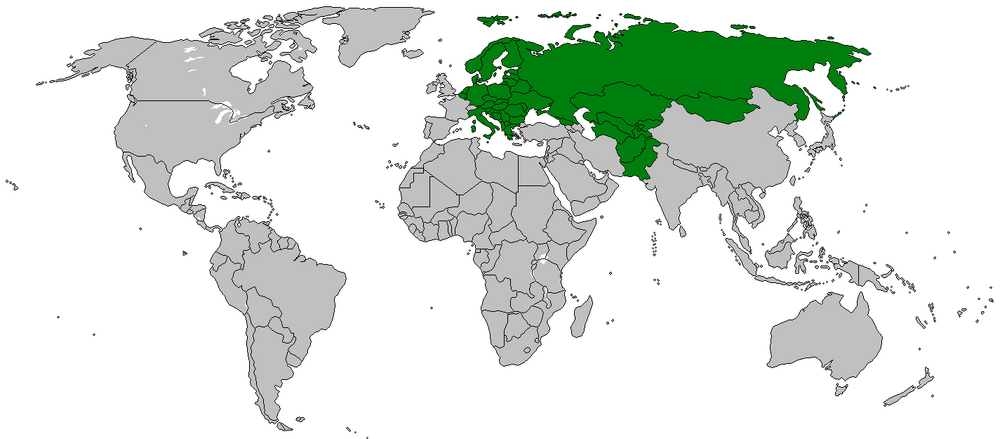After World War II, Russia was the keystone of the Soviet empire. Check these maps that correspond to about 1950:
The Western Soviet Union (red), Warsaw Pact Nations (blue) and Yugoslavia (green)
 |
| Source |
Extent of the Soviet Empire (green)
 |
| Source |
The Soviet Union had a huge territory, and dominated a number of central and eastern European governments which had Communist governments and traded with the USSR, Of course, the Soviet Union had some degree of influence not only in the so-called satellite nations, but in many countries in Asia, Africa and Latin America.
How Things Have Changed
Communism fell, and in 1991 the Soviet Union broke up in the Russian Federation and 14 independent nations. The Warsaw Pact ended, and many of the nations freed of Soviet domination joined the European Union and NATO. Compare the earlier geographic picture with the current situation of the Russian Federation in the west:
Western Russia, Western Europe and Western Asia
 |
| Source |
More recently, the Russian effort to create a common market with Belorus, Ukraine and Kazakhstan ran up against the likelihood that Ukraine would instead join the European Common Market.
In Asia
While Japan had been a rival of the Soviet Union in Asia in the early 20th century, the defeat of China in World War II removed any threat from that quarter. China, when a Communist regime gained full control of the mainland at mid century, seemed a reliable Soviet ally. However, there was a split with China in 1961 and a brief border war in 1960.
Japan was aided to restore its economy after losing World War II, and has become a key ally of the Western Powers. Other Asian countries have emerged as economic powers.
Thus Russia is no longer the greatest economic and military power in east Asia, and no longer might depend on China, which is perhaps now a capitalist competitor in global markets, rather than a Communist ally in a global political competition.
The Change in Russia's Situation
Thus the Russian empire in the 1950s had expanded to a maximum size and appeared to have secured its borders. (Threats from Turkey and Iran, which had been significant in centuries past, were no longer seemed credible.) It had all year ports on the Black Sea and the Pacific. Military threats from Japan had been eliminated, and it had what appeared to be a reliable ally in China.
Today, the empire is much reduced in extent. A significant portion of ethnic Russians now live in foreign lands. While there seems little immediate threat of war with other nations, the barrier of friendly or neutral nations seems much less secure.
Consider the following data (there is a good visualization site which shows the failure of Russia to keep up economically):
Russian Federation: population: 143.5 million, GDP: $2.1 trillion
China: population: 1.36 billion, GDP: $8.3 trillion
India: population: 1.2 billion: GDP: $5.3 trillion
European Union: population: 507.9 million, GDP: $16.8 trillion
United States: population: 318 million, GDP: $16.8 trillion
Japan: population: 126.7 million, GDP: $4.7 trillion
Vladimir Putin was born in 1952, when Moscow was the capital of a global power that saw itself competing with the United States. He was educated in schools that were still using curricula based on confidence in Russian power and influence. As an adult he lived through Glasnost, the fall of Communism, and the break up of the Soviet Union. He now finds himself the President of a country that has lost its former empire, and that faces much larger populations and economies, in a capitalist world characterized by global financial and trade patterns.
Russians of his age must be wondering what has happened to the world, and what role Russia has to play in the world today.
No comments:
Post a Comment